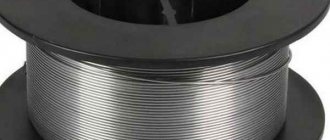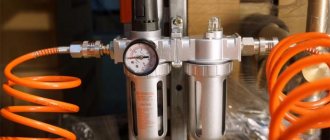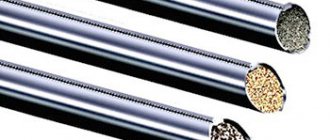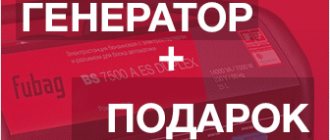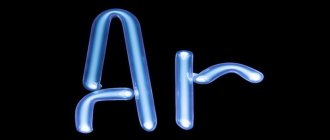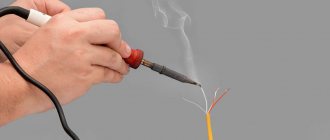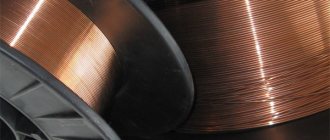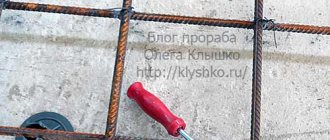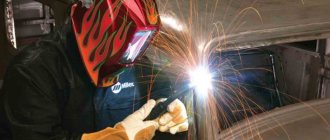Welding machines are a very common technique used both in industry and in everyday life. If you have a good welding machine and know how to use it, you can solve many problems, for example, fix something, patch something, even design something. Ideally, this is done using gas and filler wire, but sometimes you need to work urgently, and a spare gas cylinder may not be at hand, and the main one is not filled, and in general cylinders are very bulky, which makes them impractical. In such situations, the question arises: is welding possible without gas? Whether this will work will be discussed later.
Features of the method
The connection of metal parts using semi-automatic welding occurs as a result of the continuous supply of a fusible electrode. A hollow tube of a certain diameter acts as an electrode. Melting occurs from an electric arc.
In industry, there are two ways of operating a semi-automatic machine:
- the use of a gas environment is necessary subject to the requirement of protecting the seam from oxygen;
- welding without gas frees the welder from the difficulties associated with moving equipment, as well as constantly replenishing the container.
In order to avoid labor costs, it is recommended to use semi-automatic welding without a gas environment. A flexible tube is used; the material has a cavity inside; during the manufacturing process, the void is filled with flux, it is heated, and gas is released. The seam is protected from the action of foreign substances. The benefits include:
- powering the device from the central network using wires;
- mobility of the device;
- continuous supply without stopping to replace the electrode.
Equipment for work
To get started, you need a welding wire feeder and a power source, welding wire and shielding gas (when working in a shielding gas environment). The gas used is carbon dioxide CO2, or a mixture of carbon dioxide and argon, the standard mixture is 80% argon and 20% carbon dioxide.
First, you need to decide on the operating conditions of the device: how many hours it will be in continuous operation, what thickness of metal will be welded. So, for example, if the metal thickness is 5 - 10 mm, then the required current of the semi-automatic device should be approximately 50 - 400A. If the device is intended for permanent connection of automotive iron with a thickness of 0.8-0.6 mm, a power of up to 200 A is sufficient. It is also necessary to determine how long the continuous operation will last. If this time exceeds more than 4 hours. Then it is necessary to choose a device with a payload of more than 60%.
Wire selection
For welding without gas, flux-cored wire is required. It is a hollow metal tube filled with special flux and steel chips. It is installed in a special mechanism for uniform feeding. The welding wire is selected according to the material to be joined.
Advantages and disadvantages of cored wire
Advantages:
- flux-cored wire welding does not require an additional gas environment;
- the ability to move equipment to any location;
- performing work in hard-to-reach places;
- high speed method of joining metal parts.
Flaws:
- high cost of consumables;
- The quality of the seam is worse compared to the gas method.
Refueling and consumption
To weld with wire, you must do the following:
- Rollers of a certain diameter are installed on the device;
- It is not recommended to tighten the clamping mechanism with force;
- the tip on the welding head is removed;
- when the end of the material appears on the head, the tip is put on again;
- To protect against splashes of molten metal, it is necessary to carry out treatment.
The flux material is selected depending on the metal being welded. In this case, the flow rate is regulated on a semi-automatic device and depends on the magnitude of the electric current.
When to weld with flux-cored wire without gas
In principle, you can always cook; in such cases there is no need for protective gas. The only drawback is the price; it is quite high for self-shielding wire for a semi-automatic machine, so not everyone can afford to weld with cored wire every day.
The second point is related to the fact that it is not always possible to deliver gas cylinders to the welding site. Well, let's say you need to cook at a height. How to deliver a carbon dioxide cylinder there? That's right, it will be better and faster to weld semi-automatically using flux-cored wire.
The next point is related to weather conditions. As you know, the main enemy of semi-automatic welding is the wind. If the weather is windy outside, the shielding gas will simply blow off, which will negatively affect the quality of semi-automatic welding.
Consequently, cored wire will also help get rid of this problem; it can be welded even in very windy weather.
Necessary equipment and types of wire
For connection without gas, any device with the ability to switch reverse polarity to direct polarity can be suitable. When using wire with flux, select a semi-automatic welding machine without gas. In this case, it is necessary to connect the terminals of the equipment, as when working with electrodes. The result will be increased arc output energy, as well as temperature at the weld.
Initially, the feeding mechanism is debugged. The resulting distortions can damage the material and reduce the quality of the connection. When choosing equipment, consider:
- small size for quick movement;
- smooth adjustment of the electric arc;
- use of various materials.
The following types of wire are distinguished:
- with flux core;
- with metal powder core.
Wire for semi-automatic machine
Equipment setup
The selected parameters will help you connect metal parts with a high-quality seam. Pre-requisite:
- determine the amount of electric current to be supplied to the equipment terminals;
- configure the inverter welding machine according to the specified parameters;
- install a set of gears on the feed mechanism;
- make a test seam on a piece of metal;
- After making sure that the parameters are set correctly, perform a metal connection.
Table of technical characteristics of wire for aluminum parts
| Base metal to be welded | Filler material (welding wire) universal | Filler material (welding wire) special to ensure special weld properties | |||
| Resistance to hot cracks | Tensile strength | Relative extension | Corrosion resistance | ||
| A99, A97, A95 | A99 | A99 | SvA85T | A99 | A99 |
| AD0, AD1 | SvA5 | SvA5 | SvA5 | SvA97 | SvA97 |
| Amts | SwAMts | SwAMts | SwAMts | SwAMts | SwAMts |
| AMg3 | SvAMg3 | SvAMg5 | SvAMg5 | Avch | Avch |
| AMg5 | SvAMg5 | SvAMg6z | SvAMg6 | SvAMg5 | Sv1557 |
| AMg6 | SvAMg6 | SvAMg6z | SvAMg6 | SvAMg6z | Sv1557 |
| AB, AD31, AD33 | SvAK5 | SvAK5 | Sv1557 | Sv1557 | Avch |
| 1915 | Sv1557 | SvAMg5 | SvAMg6 | SvAMg5 | Sv1557 |
How to cook semi-automatically without gas
Semi-automatic welding without gas using regular flux wire is performed according to the following algorithm:
- metal parts must be pre-prepared; to do this, clean the joint and degrease the edges;
- on the mechanism with wire, a low feed speed is set, as well as minimum voltage values;
- It is recommended to run the torch at an angle forward, the arc is intermittent;
- the equipment is set to the correct polarity for welding with flux-cored wire without gas;
- the movement rollers and the tip on the head are selected according to the diameter of the filler material;
- the end is treated to prevent the adhesion of metal splashes;
- the welding movement begins from the top of the seam, evenly without jerking;
- flux cored wire is fed to the leading edge;
- For novice welders, it is recommended to initially perform a test weld.
Joining metal by welding is a complex technological process that requires compliance with the necessary safety measures, as well as the availability of protective equipment.
Advantages and disadvantages
The method, which involves semi-automatic welding only with protected wire and without gas, has its advantages. For example:
- No need to buy and refill a gas cylinder.
- There is no need to move the gas cylinder.
- The welding machine will become lighter, since there will be no connection to the cylinder.
- When the additive burns out, the protective cloud will be so stable that neither the wind nor a strong draft will spoil it. The flow using the gas method can be spoiled by the influence of the external environment.
- Preparation for semi-automatic welding without gas is faster.
- The torch nozzle and an insufficiently dense gas cloud around the arc cannot spoil the view.
Features of the weld seam
Welding defects
After the weld is formed, a crust of slag forms on it, which flows into the weld pool. The cooled compound must be beaten off the slag coatings using a hammer. This operation is necessary for multi-pass seams. As a result, conditions are created for the adhesion of each subsequent layer. At the end of the work, the seam should be cleaned with a special metal brush.
Welding with flux-cored wire creates rough, coarse-scale seams with characteristic beads. One of the common defects is unwelded areas of the connection. The quality of the weld directly depends on the consumable material, the composition of which must correspond to the specific type of steel.
Welding without gas, like any other welding process, requires compliance with safety precautions, implementation of fire safety measures, and the use of personal protective equipment.
Video on the topic: Welding with self-shielding wire
Publications on the topic
Making argon welding at home
Features of semi-automatic welding in a carbon dioxide environment
Features of semi-automatic welding of cast iron
Welding technique
The technique has much in common both with the work of the MMA method with discrete electrodes, and with the work of a gas semi-automatic MIG/MAG .
Before starting welding, you should clean the seam area using an angle grinder to clean the workpiece from mechanical impurities, traces of rust, and remnants of old paint coatings. Next, it is necessary to thoroughly degrease the seam area and the adjacent area no less than 10 cm in order to wash off all oil and fat contaminants.
The seam edges are cut without any special features.
The burner must be moved along the seam smoothly, without jerking. The electrode should be pulled off and the arc extinguished at the end of the seam smoothly so as not to disperse the protective cloud of carbon dioxide on the cooling weld pool.
Welders who know how to weld parts with flux-cored wire without gas pay attention to the following nuance. During welding, there is still a risk that slag from the burning flux powder will unexpectedly flow into the weld pool . In this case, both the strength and durability of the seam in this area may suffer.
In this case, you should interrupt the work, clean the seam area from slag and re-weld it.
Basic operating principle
The basic principle of operation is based on the welding material: flux-containing wire.
When producing such a material, a flux-containing powder is pressed inside an elastic metal shell, its composition reminiscent of the coating of rod electrodes.
The shell serves as a filler material.
The following designs of flux-cored wire used for welding without gas are often found:
- cylindrical shell;
- double-cavity with bend,
- double-cavity with two bends,
- coaxial two-layer
The flux contains rutile, reducing agents and substances for the formation of slag . In addition, alloying additives necessary to give the weld material the required physical and chemical properties are added to the powder: Ni, Mb Mn, Fe and others.
Types of flux-cored wire cross-section profiles.
In this case, it is the shell that is used as a filler material. When flux powder burns in an electric arc flame, carbon dioxide CO2 is released . This cloud displaces air in the area of the weld pool and reliably protects the melt from contact with oxygen and nitrogen from the air, as well as from the water vapor contained in it.
As the burner moves along the seam, the cloud moves along the arc, protecting the bath until the seam material cools and crystallizes.
Device characteristics
In order to choose the right semi-automatic welding machine for working without carbon dioxide, the following nuances should be taken into account:
- the device must be light and small-sized so that there is no need for a gas cylinder;
- the device must be affordable;
- the inverter device must have ample opportunities to configure the parameters of the electric arc;
- the unit must allow the use of different types of welding materials.
When choosing a welding technology, it is also necessary to take into account the fact that carbon dioxide is heavier than air and sinks downward. Therefore, the method is unsuitable for working in the upper position and with large slopes of inclined seams : the weld pool will not be sufficiently protected. Only the most qualified and experienced welders will be able to weld ceiling seams using flux-cored wire; it is too difficult for beginners.
State standards of technical process and equipment used
The technology and process parameters are regulated by the USSR state standard of 1977, extended in 1991, GOST 11533-75 “Automatic and semi-automatic submerged arc welding. Welded joints at acute and obtuse angles.” GOST introduces designations for subtypes of the method:
- Ac – automatic submerged arc welding on a steel backing;
- Apsh – automatic submerged arc welding with preliminary application of a backing seam;
- P - semi-automatic submerged arc welding;
- PS – semi-automatic submerged arc welding on a steel backing;
- PPsh – semi-automatic submerged arc welding with preliminary application of a backing seam.
The necessary parameters of the equipment are contained in GOST 18130-79 “Semi-automatic machines for consumable electrode arc welding”, created in 1980, extended in 2015. It contains requirements for rated voltage, electrical circuits, total cable cross-section, operating conditions and other process characteristics.
Video description
How to set up a semi-automatic machine.
Polarity when working with self-shielding wire
DC welding can be with direct polarity - a plus is connected to the product, and a minus goes to the electrode; welding with reverse polarity is connected in reverse Source lemzspb.ru
As already mentioned at the very beginning of the article, there is direct and reverse polarity, which is quite clearly shown in top image. When the polarity changes, the flow of electrons in the circuit changes. We will not talk about the theories of electron motion - from plus to minus or vice versa, because it is generally considered dualistic after the creation of Alessandro Volta's column, but we will dwell on the method of working with flux-cored wire.
So, straight polarity means that there is a plus on the electrode, and a minus on the product where the polar clamp is attached. In the case of reverse polarity, everything looks the other way around - there is a minus on the electrode, and a plus on the clamp. If we talk about welding with self-protected flux-cored wire, then direct polarity is used, while when welding with a protective gas shell, reverse polarity is used. This state of affairs allows you to extract maximum voltage for the semi-automatic device, therefore, the device will operate in the most optimal mode.
Note: situations are possible when self-protected flux-cored wire is used with reverse polarity, but this depends on its marking.
Are sound waves important when working with a semi-automatic machine?
The welder cannot be deaf, and this is clear, since when working MIG/MAG it is necessary to listen to the sound coming from the weld pool area, as well as observe the process through tinted glass (especially important for beginners). If the process proceeds correctly, the sound will be similar to when meat is fried in a hot frying pan - an even hiss without crackling or explosions. If the splashes freeze on the electrode or burner, the sound will immediately change - crackling and hissing will begin, as if water is being added to a frying pan. Also, the sound quality is significantly affected by the density of the clamping mass - if the crocodile does not grip the workpiece well, then the sound will be uneven in any case.
Safety when working with semi-automatic machines
The light that is generated during any type of electric arc welding is critically harmful to vision Source samsvar.ru
“Eyes!” - anyone who was present while a professional was working probably heard this expression, which any adequate welder will certainly voice before touching the metal surface with an electrode. Eye protection when working with arc welding of any type is the most important safety requirement. To burn the iris of the eye, three or four flashes are enough, after which a feeling of “sand” and one or two sleepless nights are ensured. For this purpose, welding helmets with tinted glass are used, and some manufacturers of semi-automatic machines offer them as a factory kit: that is, the mask comes as an addition to the machine.
An important role is played by gloves or mittens that protect your hands from molten splashes and heat from the holder. In addition, any arc welding is a powerful stream of ultraviolet radiation, and if unprotected areas of the skin are exposed to such baths for at least one minute, then a serious burn is guaranteed. For example: when a mechanic works with a welder (supports some workpieces during work), then by the end of the working day a tan will appear on his face, and sometimes he even has to make anti-burn masks (sour milk, sour cream, etc.).
When working with any welding, you definitely need a protective suit that cannot be burned through by splashes of molten metal. This is also important, since even one drop on the body is tantamount to a burn. If a special suit is not available, it is important that synthetics are completely excluded from clothing, as they will aggravate the situation. Shoes should be closed, but not rag (leather or leatherette) - it is best if they are not shoes, but boots. If work is carried out indoors, proper ventilation must be provided.
Theory of semi-automatic welding
The profession of a welder, like any other, requires certain training, because you will have to work with an electrical device that has several modes. Even if an experienced welder takes on the training directly at the place of work, he will in any case, before allowing the student to make the first seam, teach him a number of theoretical lessons.
General structure of a semi-automatic welding machine
Semi-automatic welding machine is suitable for welding ferrous and non-ferrous metals of various thicknesses Source svarkagid.ru
Each semi-automatic welding machine has an inverter, where there is space for installing a spool of wire, which is fed automatically. This wire, in fact, is nothing more than a consumable electrode. Devices of this type provide the ability to independently adjust the wire feed speed and current strength, guided by production needs.
Depending on the modification of the device, it has one or another set of functions, therefore, each unit can be used to perform different jobs in work processes. Of course, for novice welders, the simplest devices are needed, where control is limited to a few functions or has synergetic control, which greatly facilitates its setup. Professionals often prefer three-phase semi-automatic devices, if, of course, it is possible to connect them to a 380 V network.
In general, the working configuration of the welding machine consists of:
- welding unit;
- semi-automatic burners;
- cylinder with reducer;
- gas supply hose;
- cable with a crocodile clip for grounding the product during operation.
Selecting the right gas in relation to the metal
Accessories for cylinders: valves, tips, flow regulators, supply reducers, etc.
purchased separately Source lagma.ua In a semi-automatic machine, any gas performs a protective function - it isolates the welding site (bath, electrode) from contact with air, but depending on the metal or its thickness, the requirements may change - the gas can be active, inert, or it's a mixture of them. If we talk about the most common ones, these are carbon dioxide (CO2) and argon (Ar), which significantly reduces metal spattering, therefore, increases the strength and aesthetic qualities of the weld.
| Steel | Gas |
| Structural | CO2 |
| Structural | CO2+Ar |
| Stainless | CO2+Ar |
| Alloyed | CO2+Ar |
| Duralumin | Ar |
Note: gas cylinders are expensive in any case, but the larger their volume, the cheaper it is for the buyer.
Features of work
As you can see in the video, working with flux-cored wire has several specific features that a welder needs to know. To successfully conduct an arc and form a seam, it is necessary to set straight polarity. On semi-automatic machines this is done by switching contacts inside the device. The wire going to the burner is connected to the ground cable, and the wire from ground is switched to the burner terminal.
It is important to install rollers that match the diameter of the wire used. The range of diameters to which they fit is indicated on the side of the roller. The pressure roller (movable) should not be tightened too tightly due to the hollow structure of the wire. This can deform it and cause a blockage in the cable channel.
To smoothly draw the wire from the clamping mechanism to the outlet of the torch, you need to remove the tip. It is screwed on after the end of the consumable element appears from this edge of the channel. The diameter of the tip is also selected to match the wire. A hole that is too large will make it difficult to control the arc. Since no shielding gas is used, it is not necessary to put on the nozzle. To prevent splashes from sticking to the tip, the latter is sprayed with a special agent.
Application of welding without gas
To operate, you must have a 220 V power source. The gasless welding method is used to obtain high-quality and reliable connections of parts of any thickness - from 1.2 to 10 mm. The method is suitable for operations with galvanized iron, carbon steel, and stainless steel. Flux-cored wire is suitable for creating seams and surfacing. It must be taken into account that the method is not used for welding broken joints of an existing water supply system.
Semi-automatic wire welding diagram
Advantages and disadvantages of the semi-automatic method of working without gas
The advantages include:
- mobility (no heavy gas equipment);
- ability to continuously weld extended joint sections;
- efficiency of visual inspection of seam quality;
- process speed;
- connecting structures in hard-to-reach places;
- productivity due to process continuity.
Disadvantages:
- high cost of work;
- need for equipment , complexity of setup;
- the complexity of cleaning seams due to the thick layer of slag;
- difficulty working with parts less than 2 mm thick.
Due to the availability and ease of operation of the equipment, semi-automatic welding without gas is used in households, garages and workshops for minor work and repairs.
Varieties and applications
Welding with self-shielding flux-cored wire is in demand in hard-to-reach places. This can be work at heights or in underground tunnels. A small semi-automatic machine can be hung on your shoulder, and to perform welding you only need a 220V socket. Due to its compactness, this technology is widely used on construction sites and installation work. Assembly and welding of metal structures in this way is very fast. But it is not suitable for welding pipes under high pressure.
The wire is widely used due to the variety of diameters, the minimum value of which starts from 0.8 mm and ends at 2.4 mm. This allows you to weld both thin sheets of steel, with a wall thickness of 1.2 mm, and thick sides up to 7-10 mm. This method can work with carbon steel, galvanized iron and stainless steel. To do this, it is important to choose the right material for the wire itself and the type of internal filler.
Equipment setup
High-quality preparation for the welding process without gas requires special setup of equipment. According to the requirements of regulatory documentation, for this it will be necessary to set the welding current value on the semiautomatic device corresponding to the thickness of the metal workpieces being fused.
The instructions supplied with the semi-automatic device must indicate the working ratios of these quantities. It is important to take them into account, since if the current value is too low, the quality of workpiece processing may deteriorate, and if the current value is too high, the part can be burned.
Then you need to adjust the t-mode of the wire feed (the speed of its movement is set by a set of several replaceable gears).
It is advisable to test the correct settings of the semi-automatic device and the choice of its operating modes on an unnecessary test product, and make adjustments if necessary.
To weld, set the feed switch knob to the “Forward” position, and then fill the flux funnel.
It is necessary to set the extension of the holder in such a way that the tip is located in the welding zone. Then move the flap of the funnel with flux to the open position and press “Start”, while simultaneously briefly running the electrode over the area to be welded.
Once a stable arc appears, you can proceed directly to the welding process. A semi-automatic device configured according to the recommendations will provide a stable electric arc without gas protection and supply the required portion of flux to the combustion zone.
Self shielding wire
To create a weld with an electric arc, it is necessary to protect the weld pool from interaction with gases in the surrounding air. For this purpose, coating of coated electrodes or inert gas is used, supplied around the filler wire from the nozzle of a semi-automatic device. But it is not always possible to deliver a heavy cylinder to the workplace, and the process with coated electrodes is too slow. Therefore, semi-automatic welding with flux-cored wire without gas was developed.
The wire structure is hollow and has several versions with one or two stiffeners. They are formed during the production of this consumable material during the process of laying the powder and turning the tubular structure. The ribs prevent the structure from creasing when lightly accidentally pressed. An electric current is supplied to the wire, which excites the welding arc. The temperature of the latter melts the metal tube from which the seam is formed and the powder contained in it. The mixture forms a gas cloud that protects the molten metal.
The powder inside the wire is flux. Its composition may differ, and this determines the use of the material. The presence of rutile and fluorite concentrate can reach 60%. The composition can be read on the packaging in the GOST or ISO marking, on the basis of which a decision is made on the suitability of this consumable for welding a specific type of steel.
